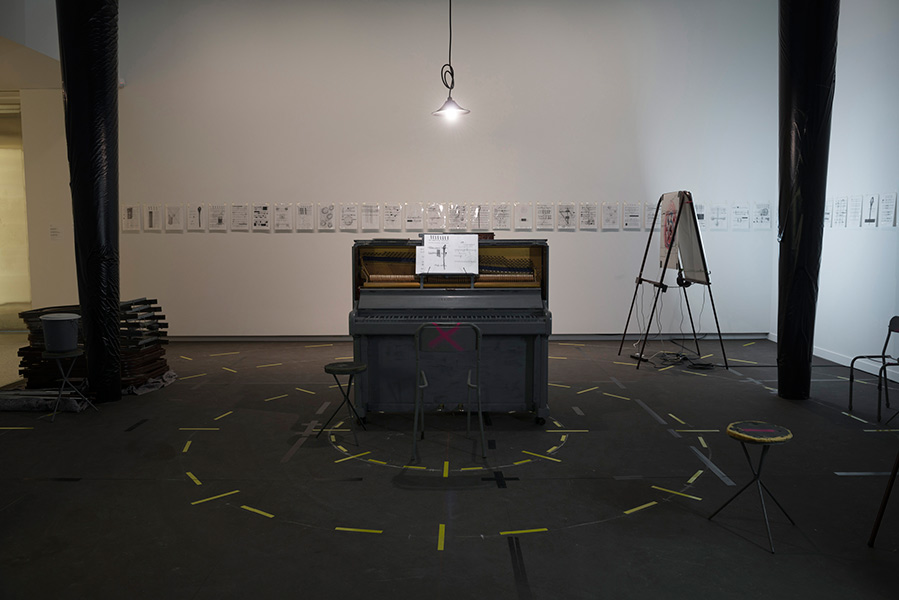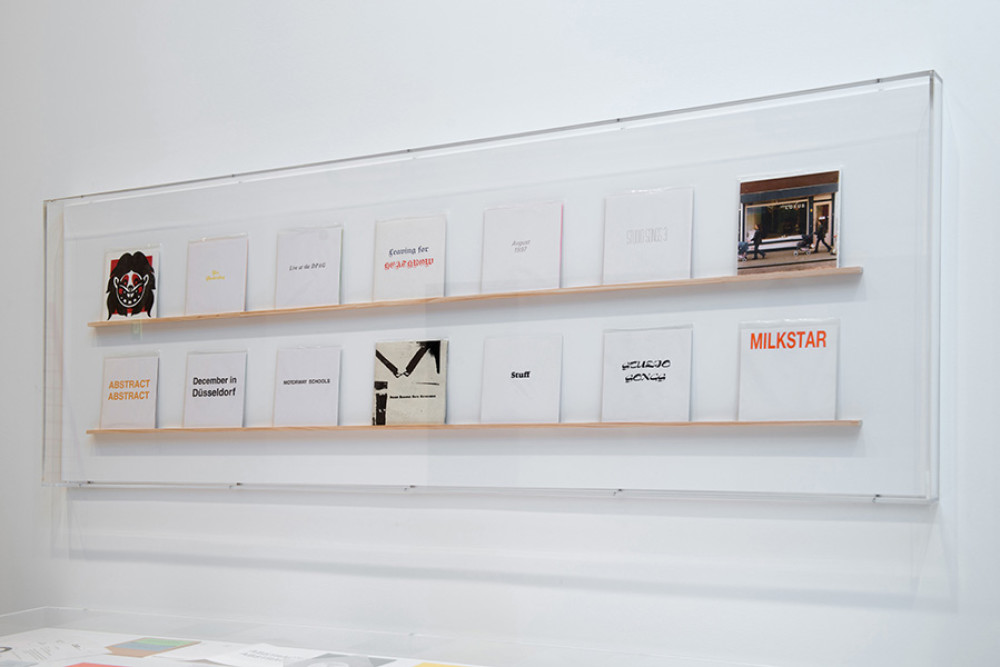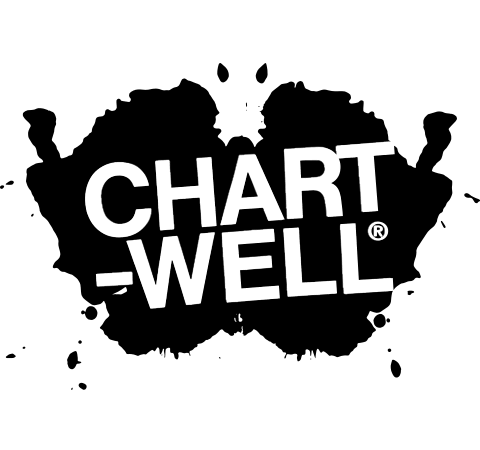Seeing the Soundscape: A Conversation between the Aural and the Visual
By Catriona Britton — 17 August 2017

et al., Samuel Holloway, Upright Piano, 2013
When you enter an art gallery, you may notice how quiet the space is. But visual art can ‘speak for itself’ – it may shout at you across the room, it may whisper in your ear intimately.
While visual art is not dependant on words, its marks can stimulate memories of music or the experiences one may have from listening or performing music. When a conversation like this occurs – between two creative art forms – an unexplainable force speeds across dimensions and collides with significant sentient impact, creating a visual and aural phenomenon.
Music is not limited to the world of sound. There exists a music of the visual world.
Oskar Fischinger
The Chartwell Collection, in the care of Auckland Art Gallery Toi o Tāmaki, contains artworks that quite clearly link music and art. On an early autumn day, I spoke with Chartwell Trust founder, Rob Gardiner.
‘The Chartwell philosophy is that everything in our lives is related in some way,’ he explained. There is a synchronicity between an image and the musical memories it conjures up, which can be reflective of aspects of our everyday lives. Collecting art that is linked with music is part of Gardiner’s wish to champion the visual arts for industry professionals, non-professionals and an audience at large in our increasingly globalised world culture – a culture that continues to favour intellectual and rational-based learning. The Chartwell Trust wants to be an advocate for the music of painting and the significance of ‘visual music’.
Phil Dadson’s January Music (paper, hand, ink, eye, wind) #23, 2014 in the Chartwell Collection, is a series of sheets of paper on which colourful Indian ink appears in splotches or fine lines like veins. Arranged on the wall, January Music evokes a calendar month composed of days of colourful soundwaves – a synaesthete’s dream recorded for all. The interconnections between colour, mood and form is striking as heavy dark blocks contrast the thin, spindly lines. Dadson left the ink to dry out in the open air and the wind directed its movement and final marks. In this way, the arbitrariness of natural phenomena, much like American avant-garde composer John Cage’s work, directs the form of the work. This improvisational quality echoes Dadson’s career as a musician in the group From Scratch, which utilised large home-made percussive instruments such as PVC pipes in their performances.
Cage himself had an active relationship with visual art and music. He once said:
‘I had early seen that musicians were the people who didn’t like me. But the painters did. The people who came to the concerts which I organised were very rarely musicians – either performing or composing. The audience was made up of people interested in painting or sculpture.’
Cage struck up a friendship with Robert Rauschenberg, a key figure in the emergence of pop art. In 1951, Rauschenberg created White Paintings, a number of canvases he painted white using a conventional paint roller. Deceptively simple, the paintings caused an uproar among the public and critics alike as Rauschenberg prompted viewers to question the boundaries of what art was and what it wasn’t. Closer inspection of these works reveals a kind of motion as, depending on their surroundings, differences in light, shadow and texture never appear the same to every person. Cage referred to the White Paintings as ‘poetry of infinite possibilities’.
One of Cage’s most famous compositions, 4'33", was a direct response to White Paintings. The performer is meant to sit at the piano and prepare to play, however they produce no sound. The composition’s content, then, is arrived at by chance – it’s whatever arbitrary sounds you hear around you – but the form is determined as the performer sits there for four minutes and thirty-three seconds. Also known as The Silent Piece, Cage challenges listeners in the same manner as Rauschenberg, but instead asks them: What is music? Cage wanted to show that there is no such thing as ‘true silence’, but that music can exist in the most mundane or everyday sounds. With Cage abandoning traditional elements of music, including melody, timbre and rhythm, and Rauschenberg abandoning fixed form, the environments of the experience informed their works and showed the bare essentials of visual art and music in conversation.
Gardiner believes that a significant aspect of music is its occupation of time. As a consumer, one must give a certain length of time to listen. Logically, the amount of time you give to music equates at least to the time it takes to perform/produce the work. However, the ongoing effects of listening to music continue well past its performance and its experience. When viewing an artwork, the visual experience shares this effect. Combined together, music can help extend the effect of the visual experience over time and expand the boundaries of sensory experience beyond the canvas or sculpture.
This idea was tested in late April at the Auckland Philharmonia Orchestra’s concert, Gallery in Sound, which occurred in collaboration with Auckland Art Gallery. It featured Ravel’s orchestration of Mussorgky’s Pictures at an Exhibition and five new works by New Zealand composers Chris Adams, Sarah Ballard, Linda Dallimore, Glen Downie, Reuben Jelleyman, inspired, respectively, by artworks on display at Auckland Art Gallery – Petrus Van Der Velden’s Otira Gorge, 1912, James Chapman Taylor’s The Wing in a Frolic, circa 1945, Gretchen Albrecht’s Aotearoa – Cloud, 2002, Jean Horsley’s Hot Coals, 1988, and Gretchen Albrecht’s Golden Cloud, 1973. The composers took the form of the art into consideration when transcribing what they experienced or saw into music: mixed visual elements transformed into dark-sounding and innovative percussive instruments, motion and dualism transformed into a mixture of orchestral control and improvised intuitive solo singing, up and down brushstrokes transformed into glissandos, rhythmic brushstrokes transformed into erratic rhythms, and washed and filtered colours transformed into cyclic musical phrases and overlaying textures. The dialogue transported the audience into the artwork themselves where they could ‘hear’ every brushstroke. Gardiner would call this the ‘shared structures in sentient, aesthetic, data management’, meaning that where music composes ‘data’ in time, the visual arts compose ‘data’ in space. Both complement each other in their operation.
The 2017 Chartwell Show Shout Whisper Wail! at Auckland Art Gallery (20 May–15 October) addresses the relationships between voice or sound, image, space and time. Curated by Natasha Conland, the exhibitions calls on its audience or viewers to respond to the artists’ initiation of communication. Whether or not an artist is successful in holding our attention is determined by our willingness to open up, engage with their art or express ourselves in the environment they create.
In the first exhibition room of Shout Whisper Wail!, a collaboration between art collective et al. and composer Samuel Holloway fills a square gallery space. Pasted onto the walls are Holloway’s music scores, which resemble the dynamic interactions between composer and artist. In the centre of the room, among other sculptural elements, stands the 2013 et al. work, Upright Piano. Conland explained that ‘et al.’s long history of work with sound and voice within installation practice makes their work particularly relevant’ in this exhibition. Pages from the annotated score perch on the music stand, ready to be played. Concentric circles are taped onto the floor around the piano, as if they were stage markings, and a single light hangs above the piano adding intimacy to an otherwise ‘working’ environment. Nearby a bucket with a speaker on top every so often spurts out chaotic piano melodies, as if there is a pianist hidden nearby working on a composition. This working environment is disrupted further by a scattering of stools that wait for the musician’s audience to take their seats for a concert. People are invited to sit down at the piano and play the score, which has been overlaid with additional mark-making that disrupts the reading of specific notes on the fine musical ledger lines. The interpretation of these marks is left to the piano player, and in this way Holloway and et al. initiate an open dialogue between artist, composer and performers.
Confusion inevitably occurs when audiences are invited to interact with an object. This is not restricted to art galleries – interactive museum exhibits face a similar problem. When society has conditioned us for years to ‘look and don’t touch’, the onus turns to the artist to find a way to break down this conditioned barrier if they want us to engage physically with their art. Conland explained that Holloway ‘led the response here as from his point of view, caretaking the score, he was keen to ensure that members of the public didn’t use the piano without making an “attempt” to read the score, including the marks.’ Positioning gallery assistants in the room helps bridge what could be a blurred understanding of interaction. Gallery Assistant Madeleine Morton echoed Conland and Holloway’s specifications regarding interaction with the exhibit:
‘At first it was decided people could sit and play whatever they wanted, because no one would likely be game enough to play the marked score. Then they added the condition that we could ask people not to play if they were playing Chopsticks. Then Chopsticks was considered a real enough danger for the final call to be no playing encouraged at all, barring people wandering through and playing a few notes.’
Making such a call on audience interaction with an artwork highlights the difficulties artists and curators currently face. But restricting an audience from playing an artwork that was purposively created for interaction seems unusual. Of the times she’s been in the space, Morton says no one’s attempted to play more than a few notes. ‘Maybe because the chair in front of the piano has no seat. People sheepishly play a key or two, look bemused at the score and move on.’
But what happens when people do choose to interact with it? ‘The most visceral reaction comes when people round the corner having heard a few notes, expecting to see someone at the piano and no one is close enough to have played,’ explained Morton. ‘That quirk of the exhibition’s soundscape caught out a fair few [Gallery Assistants] as well. And every other security guard.’ Over time, she’s found that she’s been more enthusiastic about encouraging the audience to participate and letting them know they can ask her questions about it. Nonetheless, she admits ‘most seem disconcerted by any overt enthusiasm in the contemporary art space.’ Conland highlighted the positive response this work has had in the exhibition: ‘In particular, it is well known that audiences for contemporary art enjoy immersive experiences which engage multiple senses.’
Upright Piano will be ‘activated’ with four scheduled performances over the course of the exhibition. ‘It was always the artists’ intentions,’ Conland explained, ‘that the work would have “redactions” or performances of a highly varied nature from professional pianists and/or improvisational [pianists] taking into account both the score itself, the visual markings and the form of the altered piano itself.’

Julian Dashper, Sound Recordings 1980–2001
Julian Dashper’s Sound Recordings 1980–2001 also feature in Shout Whisper Wail!. The records include a more obvious interactive element compared to other aspects of the exhibition in that people are encouraged to pick up the attached headphones and ‘play’ the records on an iPad. As such, the art of sound recorded by Dashper travels through two mediums – from polycarbonate record which has then been transferred digitally onto a tablet which allows the listener to tap on the screen and begin listening through headphones. It’s interesting to consider the reasons Dashper created physical records over this as opposed to CD-ROMs or cassettes, which were also prominent during this time. Records are known for their warmer and richer sound quality and in recent years have witnessed a revival in popularity. But at the time of this artwork’s creation, CD-ROMs and cassettes were far more accessible, cheaper and transportable. Perhaps Dashper wanted to record sounds on something that had a greater physical presence?
A record player itself is more hands-on than digital formats – you have to turn the record over, for instance. There are obvious limitations to playing Dashper’s records on record players – they risk getting scratched, mishandled or broken. In many ways, iPads are far more accessible and the more sensible choice for the exhibition. According to Conland, what the listening experience of this installation allows is the ‘contextual space’ between the art and the audience to be filled by Dashper himself acting as a conduit or bridge between the two. In this sense, the artist becomes the audience as he experiences the art first hand in the objective audience’s absence.
One of Dashper’s most well-known exhibitions was his solo show The Big Bang Theory held in Artspace in 1993. It included five drum-kits, now under the care of Chartwell Trust, with each having the name of a seminal figure in the New Zealand art scene printed on the bass drum skin, very much in the style of a band name. These include, ‘The Anguses’ (Rita Angus), ‘The Colin McCahons’ (Colin McCahon), ‘The Drivers’ (Don Driver) and ‘The Woollastons’ (Toss Woollaston). The title – The Big Bang Theory – is an obvious play on words and has two layers of meaning: ‘bang’ suggests the drums, linking music quite explicitly with the artwork; and, in line with the cosmological thinking that the universe evolved and expanded from the ‘big bang’, New Zealand contemporary visual art has evolved and been informed by these ‘rock stars’ of our artistic past.
But why did Dashper choose to link these artists with a musical instrument? Arguably, music marketing techniques have developed a greater, adoring market audience based on celebrity musical culture than has art marketing. By placing these New Zealand artists onto a stage on which they would not normally perform, Dashper creates a conversation between the reception of musicians and artists. It may be that, historically, the ‘fine arts’ have had a reputation for appealing to ‘highbrow’ individuals and so can be made more accessible to a general audience through the forms used particularly in rock or pop music which have wide public appeal. Looking more closely at Dashper’s use of these names, why did he decide to use McCahon’s full name and not just his surname like the others. Is Dashper placing McCahon on a higher pedestal compared to the others? Is this evidence of a subjective bias where Dashper believes McCahon is a one-man show leading the group or collective?
The Chartwell Collection contains many more examples of art that relates to music than discussed here, but these works help illustrate how music and visual art can influence each other in ways that are simply not possible when each is experienced exclusively. As Holloway explained, ‘Music probably has an advantage over a lot of purely visual arts in the fact that ultimately it is not representational. So it means the listener can come into the work, the world can come into the work in a particular way that maybe is not so possible in visual art works.’ Instrumental music has always appealed to complete unification of abstract forms – what you hear is what you get. There are no visual representations, no words to prompt or help you understand or make meaning of the work. As time has passed, visual art has shifted towards a similar level of abstraction. It is when the two forms are combined in their abstract forms that a dialogue and a seemingly complementary sensory experience occurs.
